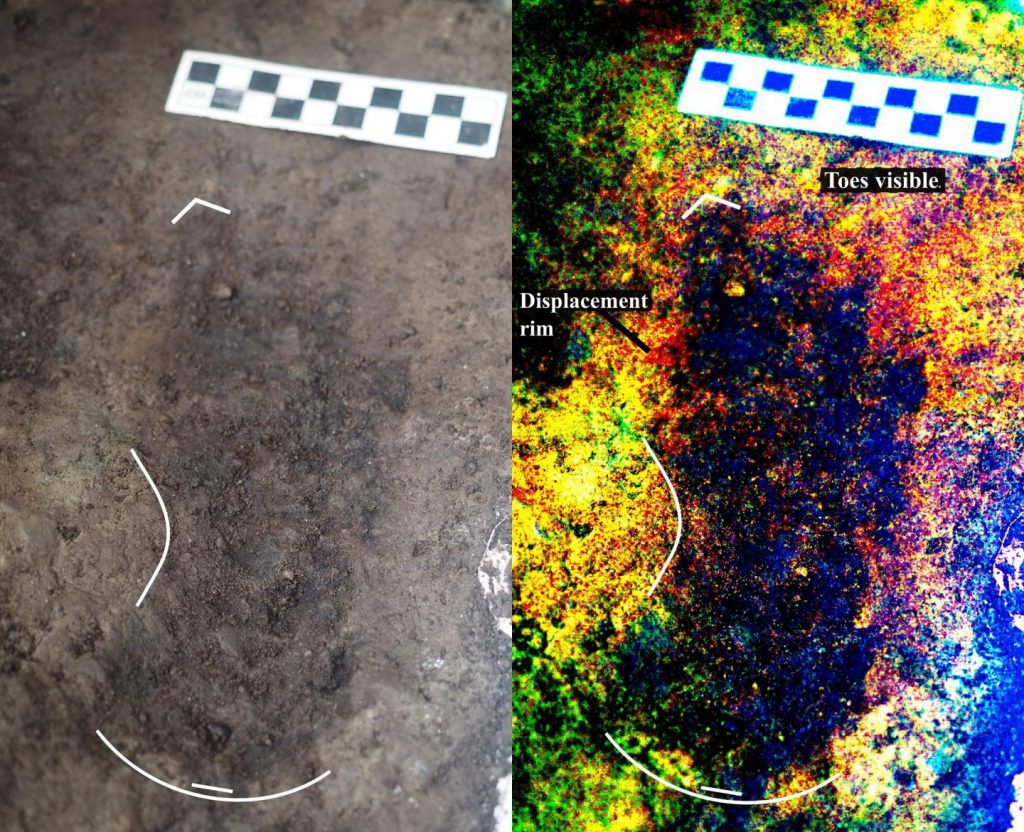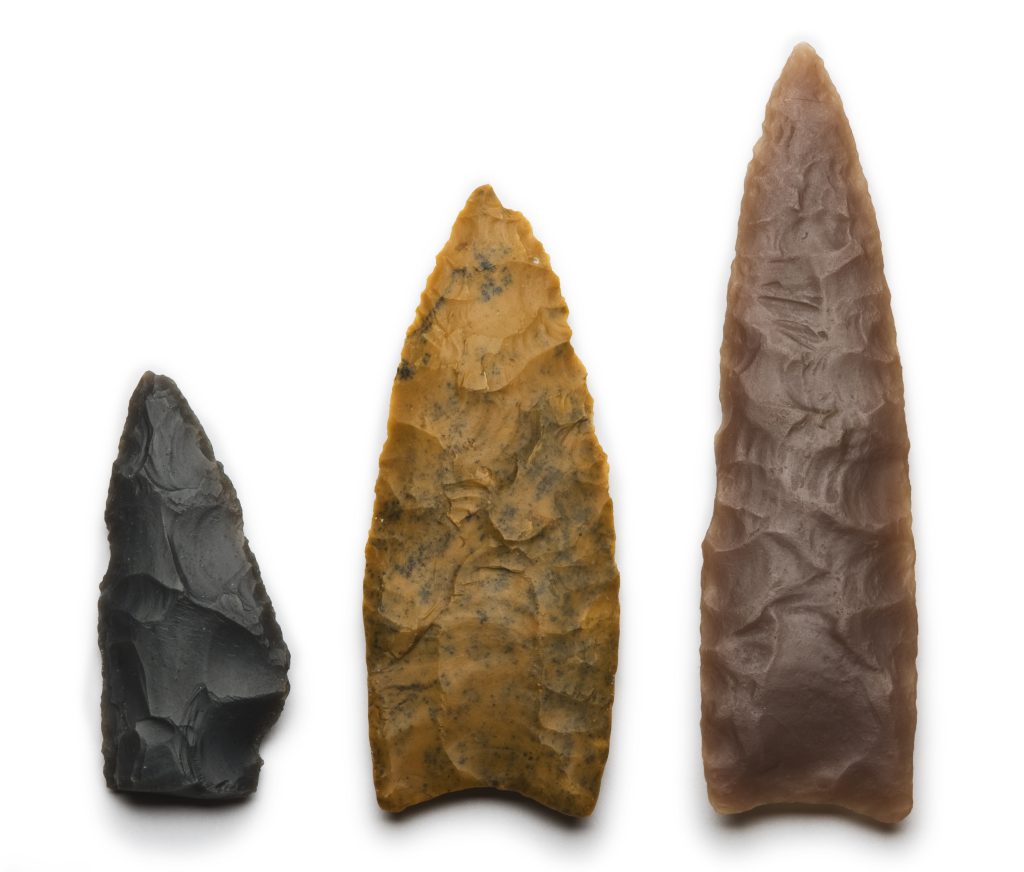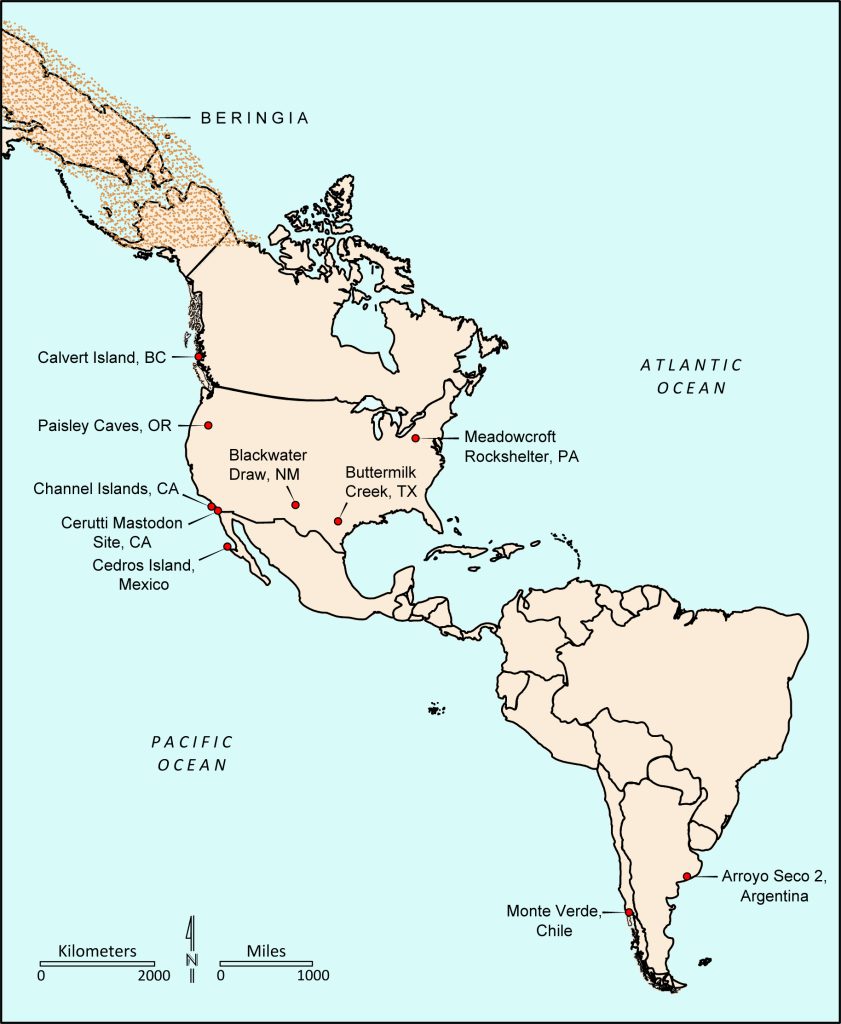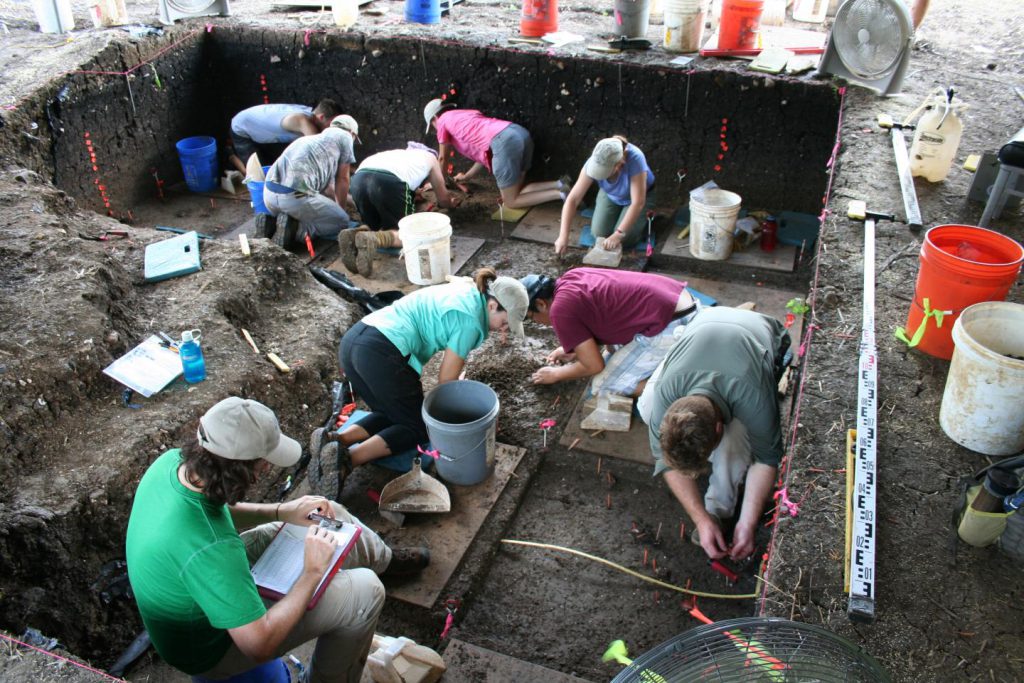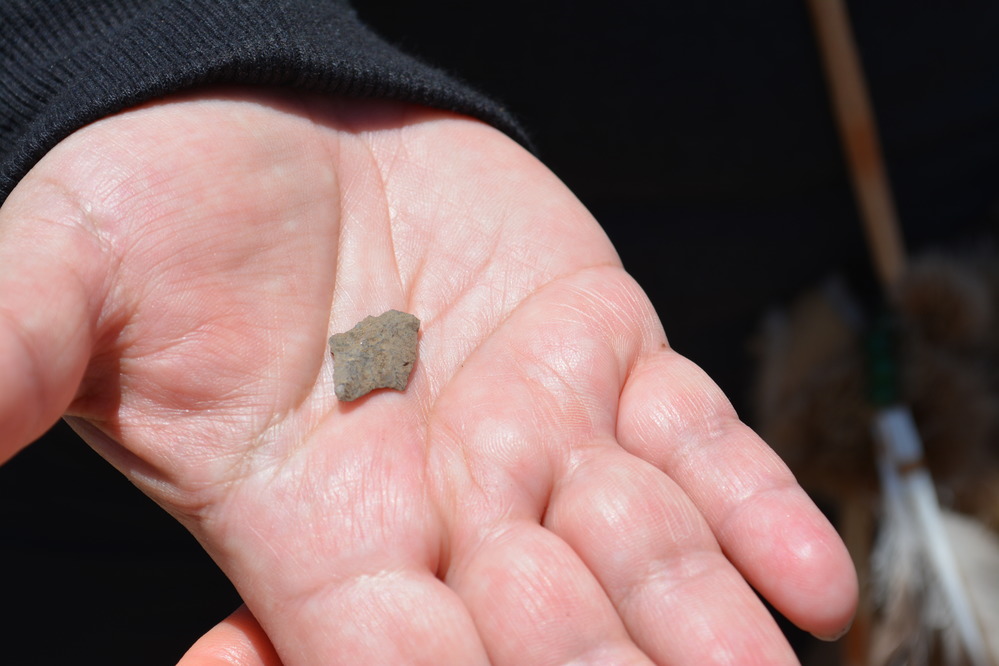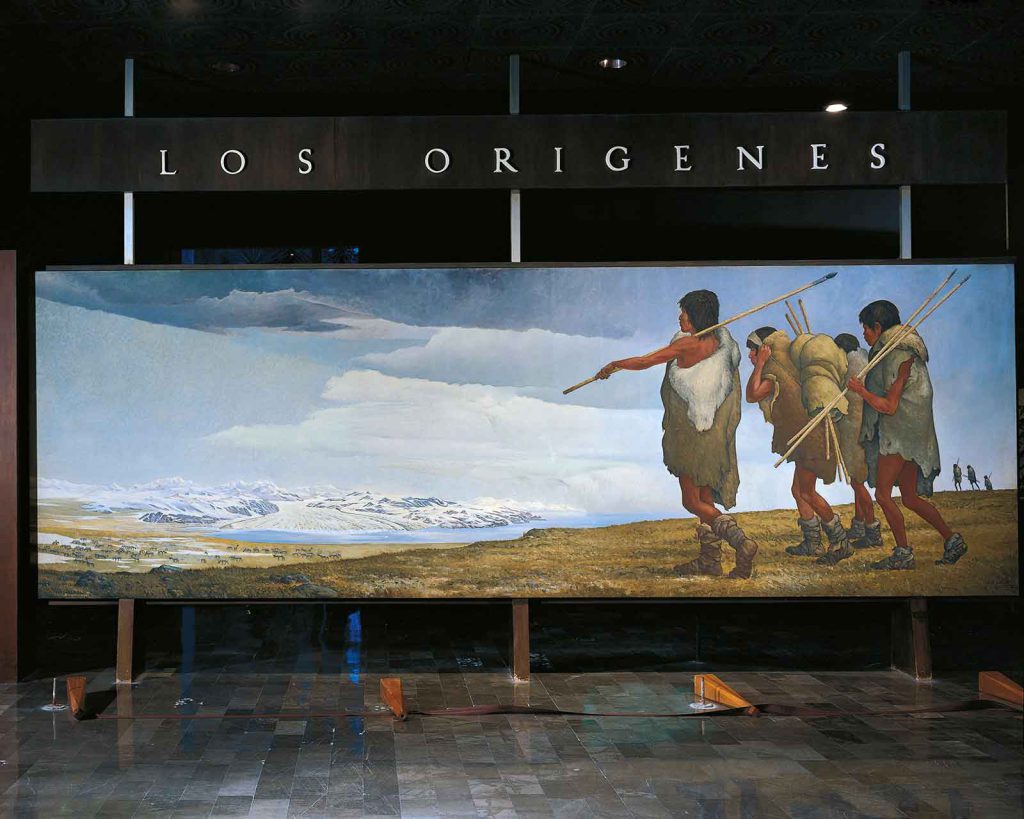The Knotty Question of When Humans Made the Americas Home
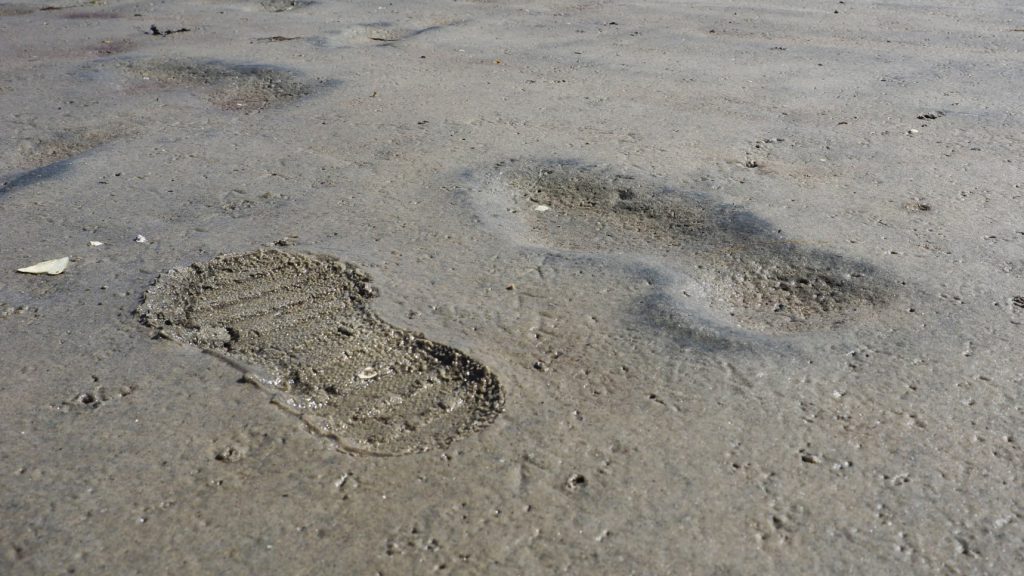
Humans have long found comfort on Calvert Island, just off the coast of mainland British Columbia. For millennia, they have climbed the island’s rocky outcrops, walked through its rainy conifer forests, and waded through its chilly intertidal pools to collect crabs, mussels, and other marine life.
There, in 2014, a group of Canadian researchers uncovered human footprints pressed into a prehistoric layer of soil. The footprints, 29 in total, are the oldest found in North America. They suggest an intimate scene in which, 13,000 years ago, at least three people may have hopped out of a boat onto the damp shore. One person appears to have slipped as the group walked toward drier land. The footprints also speak to a much larger and contested story—the tale of the humans who first set foot in North America.
North and South America were relatively lonely places for our species 13,000 years ago. The continents were the last major landmasses in the world to be populated by Homo sapiens. But the explanation of how and when this peopling happened has needed to be heavily revised in the last two decades.
“This field is bonkers right now,” says anthropological geneticist Jennifer Raff of the University of Kansas. “I think there’s a new important paper coming out every three or four months.” Indeed, no tidy, new framework has arisen to take the place of older theories. Instead, new data, including genetic findings, continue to complicate the story of how these continents came to be peopled.
As San Diego State University archaeologist Todd Braje puts it, “We know less … about the peopling of the New World now than we did 20 years ago.” (Or, as Raff puts it, we know more but are less united in a single consensus model.)
But such complications could be a good thing. The lack of consensus has pushed researchers to delve into evidence on the continental shelf and other unexpected places as they craft new narratives. In the process, non-Native scientists are also considering a long-neglected but critical perspective in this discussion: that of Native Americans.
Not so long ago, many researchers believed they had an adequate explanation for the peopling of the Americas. A single theory dominated much of the 20th century’s thinking on this question.
In 1932, geologist and archaeologist Edgar B. Howard got wind of noteworthy mammalian fossils coming from a site called Blackwater Draw in New Mexico. A construction crew had exposed an extensive deposit of bison and mammoth bones, and there Howard found spear points and other human artifacts scattered among the remains of extinct megafauna, including mammoths, camels, and bison.
Howard’s discoveries came at a time when researchers were only beginning to appreciate that humans were in the Americas during the last ice age, which ended around 10,000 years ago. In the years to follow, archaeologists would unearth sleek, fluted spear points, just like the ones found at Clovis, across North America. These artifacts came to be known as Clovis points and were “the ice age equivalent of the spread of Coca-Cola or baseball caps,” as archaeologist Tom Dillehay wrote in his book The Settlement of the Americas. The Clovis-style spear points thus came to be linked to people whom archaeologists considered the “first Americans.”
Where did the people responsible for these artifacts come from? It was long a commonplace belief among anthropologists that ancestral Native Americans descended from people living in Asia who crossed into the Americas over a now-submerged open tundra bridging Russia and Alaska, the Bering Land Bridge, also known as Beringia.
From there, these people were thought to have traversed a narrow passage between glaciers covering Alaska and Canada that only opened up about 13,500 years ago. The prevalence of Clovis-style spear points, which generally date between 13,250 and 12,800 years old, suggested that the first people in the Americas spread quickly after their arrival. Scientists broadly referred to this narrative—encompassing not just the cultural artifacts but also the time frame and land bridge—as the Clovis-first model.
The theory hit a steady stream of challenges in subsequent years, but most weren’t taken too seriously. “More than 500 archaeological sites in North and South America had been claimed to have been older than Clovis, and each of them had a Warhol-esque 15 minutes of fame until some fatal flaw was detected,” says Jim Adovasio, director of archaeology at the Senator John Heinz History Center in Pittsburgh, Pennsylvania.
Eventually, though, genuine cracks appeared in the Clovis-first model. In 1976, Dillehay was teaching at the Universidad Austral de Chile, Valdivia, when a student approached him with a mastodon molar found in a creek bed at the waterlogged site of Monte Verde in south-central Chile. Dillehay says he was initially uninterested—he had come to study Andean ceramic cultures—but when the student returned with ribs that appeared to have cut marks and burn scars, Dillehay was intrigued. The bones suggested Monte Verde might be an archaeological site.
Years of subsequent excavation at Monte Verde uncovered undeniable traces of a human presence, preserved under peat. Researchers have confidently dated the most substantial cultural layer to about 14,500 years before the present day—at least 1,000 years older than the Clovis-first model would predict. We now know that people slept there under a long, tent-like structure made of wood and animal hides and sat around communal hearths eating potatoes and seaweed brought from trips to the coast.
Clovis-first, like any scientific theory, always had detractors. But until archaeologists confirmed the age of Monte Verde and other pre-Clovis sites in the Americas, the most vocal objections were generally outliers. In 1997, Monte Verde was inspected by a delegation of archaeologists, many of whom had questioned its purported age. They left in agreement. As Alex Barker, then chief curator of the Dallas Museum of Natural History, wrote in his report: “Monte Verde is real. It’s old. And it’s a whole new ball game.”
In the last two decades, a handful of other sites, in North America especially, have gained wide acceptance as authentically pre-Clovis. Unlike the Clovis sites, most of these older sites have no distinct artifacts to connect them.
At Oregon’s Paisley Caves, archaeologists have dated fossilized human feces to 14,300 years ago. The Meadowcroft Rockshelter in Pennsylvania, which Adovasio began excavating in the 1970s, has a human history that may stretch back at least 16,000 years. Beneath the Clovis layers along the shores of Buttermilk Creek in Texas, researchers have found thousands of stone tool fragments dating back 15,500 years. At a site called Arroyo Seco 2 in the Pampas grasslands of Argentina, archaeologists have found 14,000-year-old butchered animal bones.
As researchers validate these finds, studies are chipping away at the story many of us read in textbooks. For one, the idea of a single pioneering population may have been a mistake. “It’s probably more like a dripping faucet where people are coming in at different times, from different directions,” Dillehay says.
Most archaeologists would now agree that there were widely scattered, small but culturally diverse groups of people living in the Americas at least one or two millennia before the emergence of Clovis spear points. That estimate, then, placing people in the Americas roughly 15,000 years ago, is among the most conservative.
As the Clovis-first model has fallen out of favor, even bolder chronologies have emerged. For example, one group of scientists has made a case that they have uncovered evidence of humans butchering megafauna 130,000 years ago at what is now called the Cerutti mastodon site in Southern California—though many archaeologists have contested that argument. In an article for Science, Braje, Dillehay, and a few other colleagues wrote that the collapse of the Clovis-first paradigm “has opened a Pandora’s box of alternative scenarios for the peopling of the Americas, with some scholars and members of the general public quick to accept implausible claims based on limited and equivocal evidence.” They cited the Cerutti mastodon site as one such example.
Genetics, meanwhile, has brought a daunting deluge of new findings, which also shed light on how and when entire lineages of people moved across continents. Genetic markers from the DNA of a child buried in what is now Alaska around 11,500 years ago, for instance, recently revealed that she shared equal DNA with all Indigenous populations in the Americas. The authors concluded she was likely descended from a population that stayed in Beringia, instead of spreading through the lower continents.
Genetics, meanwhile, has brought a daunting deluge of new findings.
The basic story some geneticists have gleaned from this and other finds is that a so-called Beringian population would have diverged from Siberian populations around 36,000 years ago. About 25,000 years ago, the Beringians became isolated, and a new genetic population emerged, one that scientists have confirmed relates to contemporary Native American people, splitting into two main lineages around 17,000 years ago.
Still, the genetic record is limited—there are only a handful of ice age human remains that have been studied—and archaeological data are needed to both confirm that story and fill in the ancient roadmap that humans first took across these continents.
For example, there’s a curious snag: The genetic data suggest one population may have spent thousands of years in Beringia, a period known as the Beringian standstill, before spreading into the Americas sometime during the Last Glacial Maximum between 27,000 and 19,000 years ago.
“Yet we’re not finding archaeological evidence of that,” says genetic anthropologist Ripan Malhi of the University of Illinois, Urbana-Champaign. Without archaeological finds to back this standstill up, some researchers remain skeptical of the genetic evidence.
The route that people took is also a matter of debate. Some archaeologists remain firm that humans could have walked into North America over land, although some maintain that this route would have been prohibitively ice-covered more than 13,500 years ago.
An alternate scenario has gained traction, one that claims people first arrived on boats. According to this coastal migration theory, some 16,000 years ago the ice had retreated from the coastlines of the Pacific Northwest, such that seafaring people could take advantage of coastal resources like kelp forests to navigate all the way down the shores of California, eventually reaching sites like Monte Verde in Chile.
Proving the coastal theory is tricky. No wooden boats from that era have been found along the shore. The earliest campsites along the ancient Pacific coastline may be lost for good due to erosion and sea level rise. Yet scholars have some clues that people were living along the Pacific coast, including the footprints at Calvert Island.
Evidence of human habitation from at least 13,000 years ago on the Channel Islands in California suggests that people had the skills to build boats and reach these land masses, which were islands even then. In the last 15 years, archaeologists at Cedros Island off the coast of Baja California in Mexico have found traces of a nearly 13,000-year-old settlement. Some archaeologists, such as Loren Davis of Oregon State University, are turning to methods such as coring—removing of a long column of soil—to search for hints of now-underwater prehistoric sites along the Pacific continental shelf.
Finally, many non–Native scientists are starting to appreciate that their findings have implications for Native American communities, who have had to square their own cultural narratives and more recent stories of displacement with scientific messages of how their distant ancestors came to the continents.
Native American scholars and activists were among the most vocal critics of the Clovis-first model—in particular the implication that Native Americans came to the continents over the Bering Land Bridge—from the time it was first proposed. For example, in his 1995 book Red Earth, White Lies, Vine Deloria Jr., the late Standing Rock Sioux lawyer and scholar, dismissed that migration description as “scientific folklore.”
“Language creates reality for the world,” Kim TallBear says.
To some, the scientific origin story was perceived as a means to undermine the long-term presence of Indigenous peoples on the land. After all, emphasizing how people first migrated to the Americas from elsewhere can be used to subtly imply a similarity between the ancestors of Native Americans and the European explorers millennia later. The science can be twisted to imply the land was not “really” that of the Indigenous peoples. Doing so downplays the real trauma and theft that occurred when European colonists took the lands of Indigenous peoples.
“I think subconsciously or not so subconsciously there’s this immigrant narrative, that ‘we are all immigrants,’ that drives the possibilities for how scientists and how a lot of non-Indigenous people see human history on this continent, and they are really stuck in that narrative,” says Kim TallBear, of the University of Alberta, who has studied the politics of tribal genetics and is a member of the Sisseton Wahpeton Oyate.
TallBear would also like to see non-Native scientists and writers think through their choice of words. “Language creates reality for the world,” she says. For example, referring to certain ancestral populations as “first Americans” or to the land as the “New World” can reinforce the narrative that, on some level, the Indigenous people of the Americas came from somewhere else in the recent past.
Furthermore, narratives about the first people in the Americas, TallBear notes, whether written by scientists or science journalists, tend to focus on very mechanistic and simplistic motivations for the migration, such as a search for food. She cites an article in Maclean’s magazine, for example, that presented the earliest arrivals in North America as “a bedraggled group that trudged across a submerged Bering ‘land bridge.’”
“Intellectual reasons or reasons of curiosity,” TallBear says, are ignored, as though these people had no inner life. “There’s all this language that paints people on the move and migrating as if they weren’t these fully self-actualized human beings who also had curiosity, who laughed, who had interesting kinship dynamics, who had joy in their lives.”
Fortunately, some non-Native archaeologists and geneticists are becoming more sensitive to the concerns of Indigenous people. “My job is not to tell Native groups who they are,” Davis says. “They already have their own origin stories that they have been in this place forever and ever.”
Scientists, Davis observes, try to fill those stories with numbers, quantifying how many years ago, for instance, people came to the Americas. “From the perspective of human existence—it’s like, 15,000 years? I have a hard time wrapping my head around what it means to live in a place that long. That sounds qualitatively like forever,” he says.
By working with Indigenous communities—and by increasing the number of Indigenous people who are archaeologists—scientists can avoid some of the pitfalls and narrative blind spots of their predecessors. These changes can also significantly further science, as the Calvert Island findings illustrate.
When scientists from the Hakai Institute and the University of Victoria started excavations on the island, they did so alongside representatives of the Heiltsuk and the Wuikinuxv people. Those Indigenous groups have oral histories about a strip of coast that never froze and helped their ancestors survive at a time when much of the land was covered in ice. The discovery of the footprints reaffirmed this tradition. One member of the Heiltsuk Nation told The Washington Post he imagined the people visiting the beach were a father, mother, and child.
It’s impossible to know what they were thinking or doing that day, 13,000 years ago. Maybe the mother paused to help her child out of the boat. Maybe she laughed when her partner slipped on the damp clay. Perhaps she caught his fall. Maybe she sniffed the air that stank of low tide and squinted at the ice-covered land in the distance. Maybe she had been to this beach many times before or had heard stories about it from other members of her tribe. Or maybe, as she looked inland, she wondered if she was the first person to set foot on this shore.





























